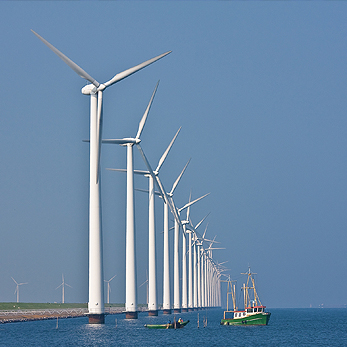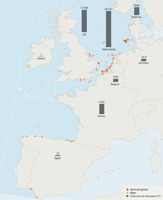Around 50 to 60 million m3 of marine mineral deposits are extracted each year, mainly for the construction industry, for use as fill sand on land, or for beach nourishment. Sand and gravel are the main materials extracted, but maerl (calcareous seaweed) is also extracted in France and to a lesser extent in Ireland to improve agricultural soils and as a filtering material in water treatment. Small amounts of shell are extracted in the Netherlands, for example, for paving hiking trails. The greatest amounts of sand and gravel are extracted in Regions II and III, with smaller amounts extracted in Regions I and IV Figure 9.10. About 80% of the total volume extracted in the OSPAR area is extracted in Region II. The biggest extractors are the Netherlands, the UK, France and Denmark. There is no mineral extraction currently in Region V, but the deep seabed is being explored for possible mineral resources, which may be extracted by new technology. Regulation of mineral extraction in the area beyond national jurisdiction is in the exclusive competence of the International Seabed Authority.
The total quantity of marine sand and gravel extracted has increased by around 30% over the past decade. However, the total geographical extent of extraction areas has been relatively stable as new concessions have been offset by extraction activity ceasing in some areas.
The main impacts from the extraction of mineral deposits are the removal of substrate and associated organisms, which can affect the stability of the seabed and lead to changes in food webs. Areas from which sand and gravel have been extracted may start to recolonise quite quickly. Biomass is restored two to four years after short-term extraction activities. Recovery after intensive or protracted periods of extraction takes longer or may not occur at all depending on local conditions. There are also transitory plumes of suspended material, but the impacts, including lowered dissolved oxygen and interference with foraging fish and seabirds, are considered negligible. Extraction also causes underwater noise.
EIAs should ensure that damage or loss of habitats that OSPAR has identified as threatened or in decline, for example, maerl beds or Sabellaria spinulosa reefs, is minimised or avoided. Because it forms very slowly, maerl is considered a non-renewable resource and even extracting dead material can have major ecological effects. Sand and gravel extraction often takes place in areas of mixed sediment where Sabellaria spinulosa reefs occur and so there is a risk of damage to reefs, although they are known to exist close to extraction sites without any harm. The EU Habitats Directive requires Member States to take appropriate management measures to ensure that any exploitation of maerl is compatible with maintaining the habitat at a favourable conservation status. Maerl beds are included in several protected areas in Region III.
All OSPAR countries undertaking large amounts of sand and gravel extraction have legislation in line with the EU EIA and Habitats Directives. OSPAR countries have agreed to apply guidelines developed by the International Council for the Exploration of the Sea (ICES) for managing the extraction of marine sediments. These also address nature conservation and conflicts over space between different users. Belgium, Denmark, Germany, the Netherlands and the UK have required sand and gravel extractors to use black-box recorders to monitor changes in the geographical extent of extraction activities in real time.
The use of ICES guidelines and EIAs has proved successful for managing extraction of sand and gravel in some areas, for example the Channel (UK). The stable, or in some areas decreasing, geographical extent of extraction has reduced conflict between different coastal users, but this has been offset by an increase in the intensity of extraction, potentially slowing the recovery of affected areas. Comprehensive extraction data are not reported by all OSPAR countries. Also, the threshold at which countries require EIAs and the quality of the assessments themselves are very variable. Without accurate data, it is difficult to assess whether regulation has improved the protection of benthic ecosystems.
Demand for marine sand and gravel in coastal protection schemes is likely to increase as sea level rise and the growth in infrastructure projects drive requirements for marine sand and gravel for construction purposes. Efforts to reduce the negative impacts from sand and gravel extraction will therefore be required. These should include stringent implementation of the ICES guidelines, harmonised and accurate reporting on the extent and impact of extraction, and follow-up activities to EIAs. OSPAR should promote research to address gaps in knowledge on the impacts of sand and gravel extraction on fish and small benthic fauna, on long-term recovery of the seabed and on the feasibility of restoring the seabed, taking into account other activities that may impact the seabed. Regional approaches for managing sand and gravel extraction should be considered. These may require cooperation between different countries if a resource is on or near a national boundary.


